8 Best Native Plants for Northern Virginia
BY CECILIA ACEVEDO | MAY 1ST, 2023 | LANDSCAPING, NORTHERN VIRGINIA, VIRGINIANorthern Virginia has some of the most stunning landscapes in the United States. With rolling hills, sprawling forests, and winding rivers, it’s no wonder that residents and visitors alike are drawn to the region’s natural beauty. One of the most rewarding ways to connect with the environment is by planting the best native plants for Northern Virginia that thrive in this unique environment.
Learn more about eight native plants that will add color, texture, and interest to your Northern Virginia backyard. From vibrant wildflowers to amazing groundcovers, there’s something for everyone to enjoy in this guide.
Native plants offer the following benefits:
- Adaptability: Native plants are adapted to the local climate and soil conditions, requiring less maintenance.
- Biodiversity: Native plants support the local ecosystem by giving habitat and food for birds, insects, and other wildlife.
- Soil conservation: Native plants help prevent erosion and improve soil quality by promoting healthy root systems.
In this article, we’ll cover the following:
- 8 Native Plants for Your Northern Virginia Yard
- How to Choose Native Plants for Your Northern Virginia Landscape
- FAQ About Native Northern Virginia Plants
- Where to Find Native Plants in Northern Virginia
8 Native Plants for Your Northern Virginia Yard
1. Red Columbine (Aquilegia canadensis)
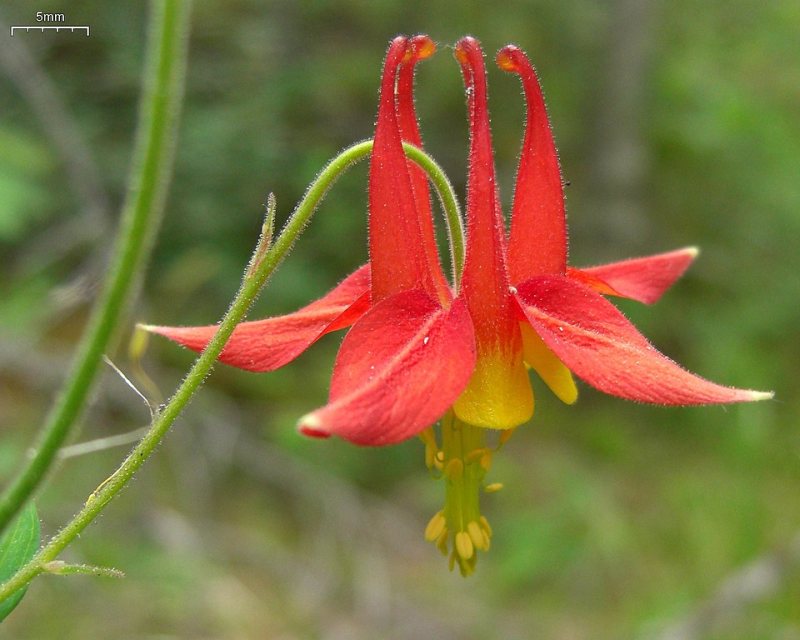
Photo Credit: Jason Hollinger / Wikimedia Commons / CC BY 2.0
The red columbine makes a spectacular and eye-catching addition to any Northern Virginia backyard. Its upright stems boast spurred flowers adorned with vivid scarlet sepals, yellow petals, and copious yellow stamens.
Moreover, even after the blooms have withered away, this plant develops into a charming ground cover that adds depth and intrigue to your garden. Additionally, red columbine has a natural tendency to self-seed, ensuring an endless array of vibrant hues that will grace your garden year after year.
Plant type: Herbaceous
USDA Hardiness Zone: 3 to 8
Sun: Full sun to partial shade.
Soil: Chalk, clay, loam, sand. Acid, alkaline, neutral. Moist but well-drained.
Duration: Semi-evergreen perennial.
Fragrance: No fragrance.
Bloom time: Spring and summer.
Water needs: Low to moderate.
Mature height: 8 – 10 inches.
Potential hazards: The sap may irritate the skin.
Maintenance: Low. Low. For enhanced blooming, it is advisable to remove the faded flower stems. Trimming the stems to ground level is recommended when the foliage begins to decline.
2. Common Yarrow (Achillea millefolium)
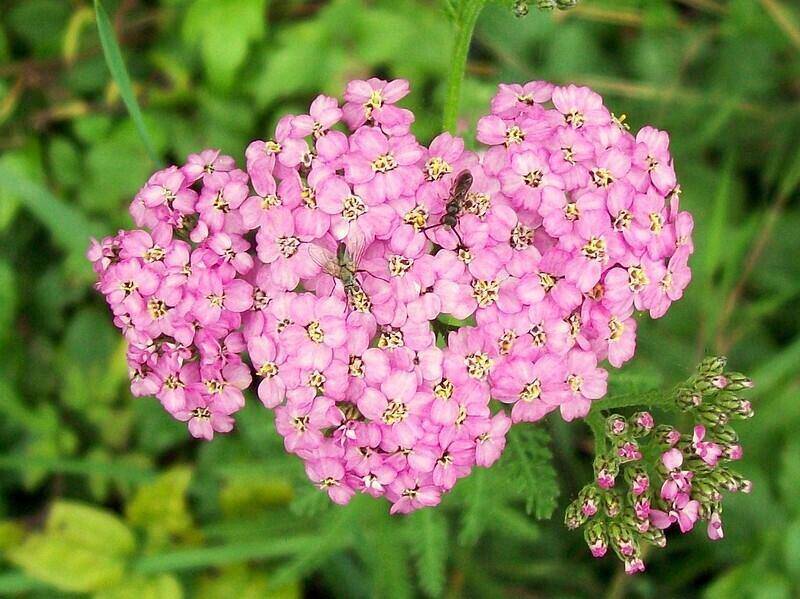
Photo Credit: Peter O’Connor aka anemoneprojectors / Flickr / CC BY-SA 2.0
If you want an effortless but captivating element in your yard, consider adding the common yarrow. This plant forms clumps and showcases dainty clusters of soft pink flowers on strong, upright stems, which will capture the attention of fluttering butterflies and bees.
Moreover, common yarrow is exceptionally low-maintenance, making it a perfect option for individuals with busy schedules who desire to appreciate the charm of native plants in their outdoor areas.
Plant type: Herbaceous
USDA Hardiness Zone: 3 to 9
Sun: Full sun
Soil: Chalk, loam, sand. Acid, alkaline, neutral. Moist but well-drained.
Duration: Deciduous perennial
Fragrance: The fragrance of the plant is frequently characterized as strong, with some comparing it to chrysanthemums, whereas others perceive it as having a resemblance to cabbage.
Bloom time: Summer and early autumn.
Water needs: Low to moderate.
Mature height: 2 – 3 feet
Potential hazards: It is toxic to dogs, cats, and horses.
Maintenance: Low. To achieve an extended blooming season, it is advisable to regularly remove spent flowers. Once the initial blooming has ceased, trim the plant considerably to maintain a tidy and well-proportioned appearance.
3. Yellow Wild Indigo (Baptisia tinctoria)
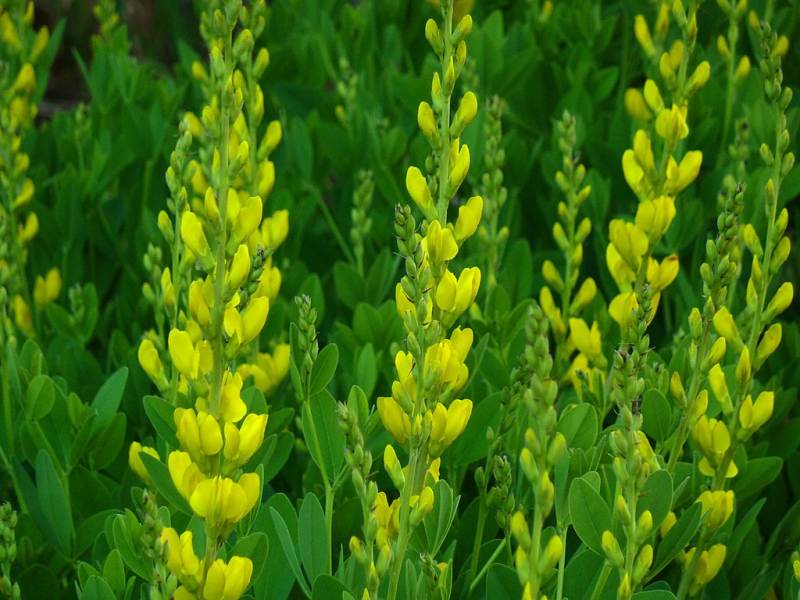
Photo Credit: Katja Schulz from Washington, D. C., USA / Wikimedia Commons / CC BY 2.0
Consider adding the Yellow Wild Indigo if you desire a joyful and low-maintenance plant. Its charming, petite pea-like flowers in vivid hues of yellow to creamy white are sure to infuse your garden with a sunny disposition. As a native plant, it is attractive. It entices pollinators like butterflies and bees, making it an ideal inclusion for any garden.
Plant type: Herbaceous
USDA Hardiness Zone: 3 – 9
Sun: Full sun to partial shade.
Soil: Sand. Acid. Moist but well-drained.
Duration: Deciduous perennial.
Fragrance: No fragrance.
Bloom time: Late spring and summer.
Water needs: Dry to moderate.
Mature height: 2 – 3 feet
Potential hazards: Poisonous if consumed in large quantities.
Maintenance: Low. It is advisable not to relocate this plant once it has established itself. Attempting to grow it from seed may pose a challenge.
4. White Turtlehead (Chelone glabra)
The white turtlehead is a mesmerizing and beautiful native plant species that showcases dense terminal spikes of two-lipped, pink-tinged, or white flowers resembling a turtle’s head.
Incorporating the white turtlehead into your garden will make your space unique and intriguing. It entices pollinators such as butterflies and hummingbirds, infusing your outdoor area with vibrancy and liveliness.
Plant type: Herbaceous
USDA Hardiness Zone: 3 to 8
Sun: Partial sun.
Soil: Chalk, clay, loam. Acid, alkaline, neutral. Moist but well-drained.
Duration: Deciduous perennial.
Fragrance: No fragrance.
Bloom time: Late summer and autumn.
Water needs: Moderate to high.
Mature height: 2 to 3 feet
Maintenance: Low.
5. Maryland Goldenaster (Chrysopsis mariana)
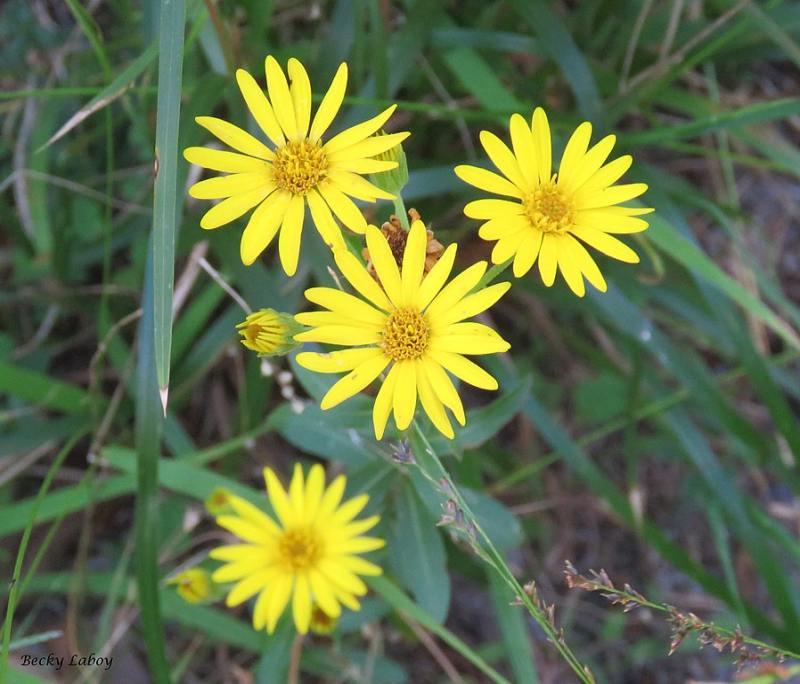
Photo Credit: BeckyLaboy / Wikimedia Commons / CC BY-SA 4.0
If you want to incorporate a touch of golden radiance into your backyard, consider the Maryland goldenaster. This stunning plant flaunts brilliant yellow flowers illuminating any garden with their cheerful glow. Moreover, the Maryland goldenaster is a sturdy and versatile species that can flourish in different soil types and lighting conditions, making it an adaptable inclusion to any backyard scenery.
Plant type: Herbaceous
USDA Hardiness Zone: 4 to 9
Sun: Full sun to partial shade.
Soil: Loam, sand. Acid, alkaline, neutral. Moist but well-drained.
Duration: Perennial
Fragrance: No fragrance
Bloom time: Late summer and autumn.
Water needs: Low to moderate.
Mature height: 1 to 3 feet
Maintenance: Low. To encourage prolonged blossoms, remove spent flowers regularly. During the winter season, trim the plant down to the ground.
6. Spring Beauty (Claytonia virginica)
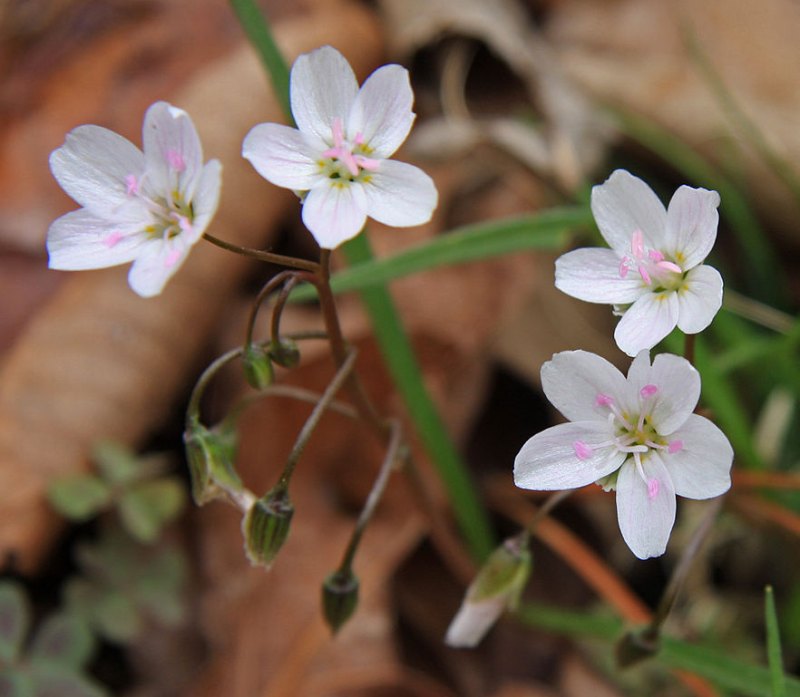
Photo Credit: Dcrjsr / Wikimedia Commons / CC BY 3.0
Introducing spring beauty to your yard will create a dazzling burst of beauty. Its star-shaped, pale pink and white flowers will not only please your eyes but also attract pollinators to your backyard. Additionally, spring beauty is a groundcover plant that spreads widely, forming a carpet of foliage that enhances the texture and intrigue of your landscape.
Plant type: Herbaceous
USDA Hardiness Zone: 4 to 9
Sun: Full sun to partial shade.
Soil: Chalk, clay, loam, sand. Acid, neutral. Moist but well-drained.
Duration: Perennial
Fragrance: It exudes a subtle and refined fragrance that combines hints of delicate sweetness, muskiness, and florals.
Bloom time: Spring
Water needs: Low to moderate.
Mature height: 6 to 10 inches
Maintenance: Moderate. It rapidly naturalizes through bulb offsets and self-seeding.
7. Eastern Rose-mallow (Hibiscus moscheutos)
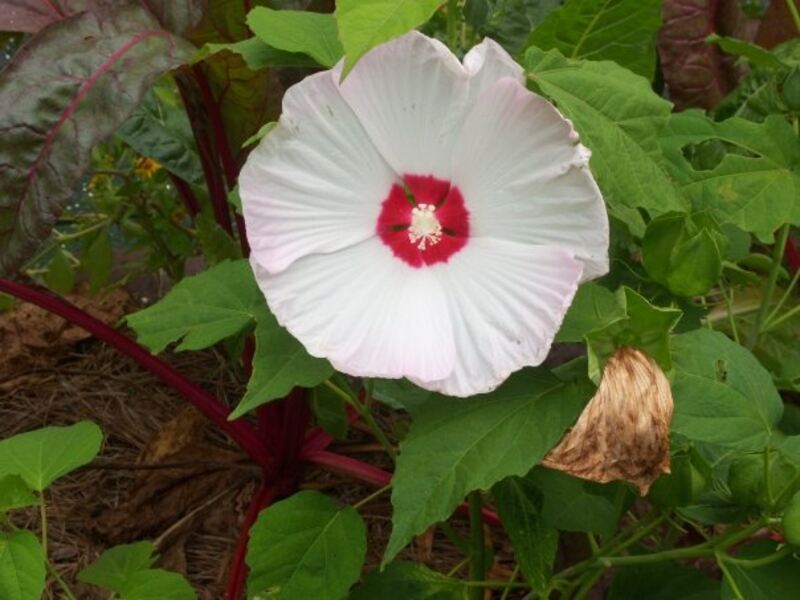
Photo Credit: Calvin Webster / Flickr / CC BY-SA 2.0
The Eastern Rose-mallow is a native shrub with magnificent hollyhock-like flowers in shades of white, pink, red, or burgundy, blossoming from midsummer to autumn. Not only does it tolerate heat, humidity, and wet soil, but it also has a slight salt tolerance, making it an ideal option for gardeners living near the coast.
Although individual flowers have a brief lifespan, the blooming period usually endures for a month, offering ample time to relish the plant’s stunning beauty in your home garden.
Plant type: Shrub
USDA Hardiness Zone: 4 to 9
Sun: Full sun.
Soil: Clay, loam. Acid, alkaline, neutral. Moist but well-drained.
Duration: Deciduous perennial.
Fragrance: No fragrance.
Bloom time: Summer to early autumn.
Water needs: Moderate to wet.
Mature height: 2 to 6 feet
Maintenance: Low. To maintain a neat appearance of your plant, remove each flower as it withers. In late autumn, trim the stems to approximately 3 to 4 inches. Although new growth may slowly emerge in the spring, it will advance swiftly once it commences. Regularly fertilizing your plants during the growing season is advisable to encourage robust growth.
8. Turk’s-Cap Lily (Lilium superbum)
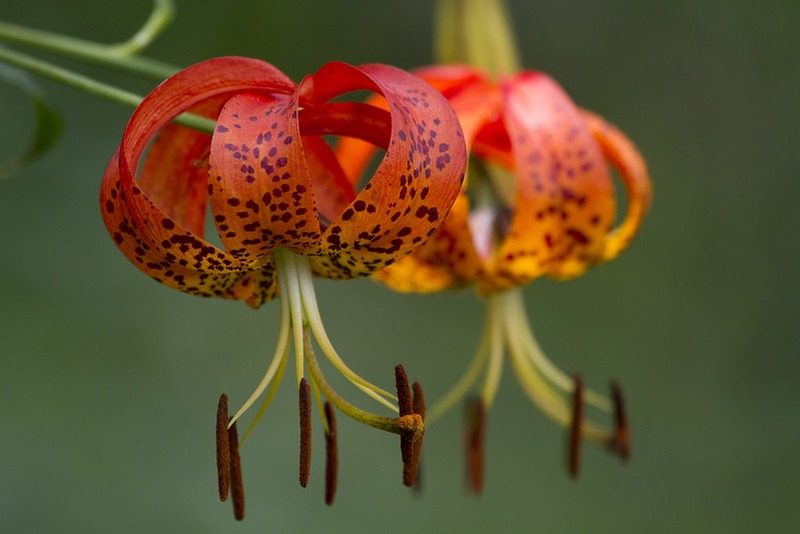
Photo Credit: Shenandoah National Park / Flickr / Public Domain Mark 1.0
The Turk’s-cap Lily is a stunning herbaceous plant that grows up to 8 feet tall and features striking clusters of orange-red flowers that resemble Turk’s-cap hats. This native plant adds beauty to your yard. It supports local wildlife, as it’s a favorite of hummingbirds and other pollinators.
With its adaptability to the region’s climate and soil, the Turk’s-cap Lily is an excellent choice for Northern Virginia yards. Including this plant in your landscape will add a distinctive and captivating element to your home.
Plant type: Herbaceous
USDA Hardiness Zone: 5 to 8
Sun: Full sun to partial shade.
Soil: Loam, sand. Acid, neutral. Moist but well-drained.
Duration: Perennial
Fragrance: With subtle notes of citrus and spice, this plant emits a pleasant, sweet fragrance.
Bloom time: Summer
Water needs: Medium to wet.
Mature height: 4 to 8 feet
Potential hazards: Toxic to cats.
Maintenance: Moderate. For the bulb to grow at its best, it is recommended to plant it 5 to 6 inches deep and add a layer of mulch to keep the soil moist.
How to Choose Native Plants for Your Northern Virginia Yard
Although native plants can enhance any garden, it is essential to acknowledge that not all will flourish in your yard. Several factors, such as sunlight, soil quality, and irrigation, must be considered when selecting plants.
Northern Virginia is situated in USDA hardiness zones 6 and 7, so ensure that you choose plants appropriate for this area. To guarantee your garden’s triumph, select plants that can adapt to the conditions of your land. Doing so will result in an attractive landscape that enhances the local ecosystem.
FAQ About Native Northern Virginia Plants
The conservation of biodiversity relies heavily on preserving areas of native vegetation remnants. Such areas support a rich and diverse ecosystem that benefits the environment by:
• Purifying water and air
• Regulating the climate
• Maintaining soil quality
• Providing essential resources and food for native animal species.
Native plants are preferable to non-native plants to promote a healthy and sustainable ecosystem.
There are plenty of native plants you can choose from. Here’s a list of them:
• Whorled Coreopsis (Coreopsis verticillata)
• Virginia sweetspire (Itea virginica)
• Eastern Redbud (Cercis canadensis)
• Black-Eyed Susan (Rudbeckia fulgida var. fulgida)
• Button Bush (Cephalanthus occidentalis)
• Common Winterberry (Ilex verticillata)
• Mountain Laurel (Kalmia latifolia)
• Witch Hazel (Hamamelis virginiana)
• Spicebush Swallowtail (Papilio troilus)
• Wild Blue Phlox (Phlox divaricata)
• Flowering Dogwood (Cornus Florida)
Generally, plants thrive in potting soil that is evenly moist but not waterlogged. Watering once or twice a week is often enough in spring and summer. However, during fall and winter, plants require less frequent watering. Keep in mind that the watering needs of plants vary depending on their species and your location.
Southeast Virginia’s native plants include:
• Red chokeberry
• Common buttonbush
• American beautyberry
• American witch hazel
• Common winterberry
• Eastern redbud
• Flowering dogwood
• Black huckleberry
• Butterfly milkweed
• Beebalm
Plants native to Virginia’s Capital Region include:
• Black oak
• Willow oak
• Sassafras
• Common partridge-pea
• Smooth oxeye
• Arrow arum
• Wild pink
• Red chokeberry
Where to Find Native Plants in Northern Virginia
It’s recommended to buy native plants from local nurseries. Plants purchased from a local nursery are usually better adapted to the area’s climate and soil, making them more resilient and easier to care for.
Local nurseries are often experts in native plants, and their staff can provide valuable advice on planting and maintenance.
Visit the Virginia Native Plant Society website to explore the available sustainability programs and native plant guides and learn about the significance of using native plants in Northern Virginia.
As you embark on your landscaping project in Northern Virginia, remember that selecting the right plant is only the first step. Maintaining your lawn’s health is equally important to ensure your landscape’s long-term success.
Looking for a Virginia lawn care pro near you? We have trusted lawn care pros in Falls Church, Arlington, Alexandria, and in many more cities across Northern Virginia.
Main Photo Credit: Katja Schulz / Flickr / CC BY 2.0